Abstract
We propose and study a class of discrete-time commensalism systems with additive Allee effects on the host species. First, the single species with additive Allee effects is analyzed for existence and stability, then the existence of fixed points of discrete systems is given, and the local stability of fixed points is given by characteristic root analysis. Second, we used the center manifold theorem and bifurcation theory to study the bifurcation of a codimension of one of the system at non-hyperbolic fixed points, including flip, transcritical, pitchfork, and fold bifurcations. Furthermore, this paper used the hybrid chaos method to control the chaos that occurs in the flip bifurcation of the system. Finally, the analysis conclusions were verified by numerical simulations. Compared with the continuous system, the similarities are that both species’ densities decrease with increasing Allee values under the weak Allee effect and that the host species hastens extinction under the strong Allee effect. Further, when the birth rate of the benefited species is low and the time is large enough, the benefited species will be locally asymptotically stabilized. Thus, our new finding is that both strong and weak Allee effects contribute to the stability of the benefited species under certain conditions.
Keywords:
commensalism model; additive Allee; flip bifurcation; transcritical bifurcation; pitchfork bifurcation; fold bifurcation; chaos control MSC:
92D25; 34D20
1. Introduction
Interactions between different species play a crucial role in shaping and maintaining balance within ecosystems. Interspecies interactions hold the potential to deliver mutual advantages, inflict harm, or yield no discernible impact on each of the participating species. These interactions are categorized by paired outcomes, symbolized as a positive, negative, or neutral result []. Commensal relationships, where one species gains a benefit while the other is unaffected, are often cited in the ecological literature, yet they receive surprisingly limited attention in research. In ecosystems, both commensalism and mutualism models involve positive interactions between populations. There is no harm in commensalism, in which one side is beneficial, while the other side is not beneficial and harmless.
A Belgian zoologist named Pierre-Joseph van Beneden was the pioneer in situating commensalism within a biological context. He contrasted commensalism with two other types of interactions: parasitism and mutualism []. In mutualism, species are interdependent and both benefit, while in commensalism, one species gains advantages without strong dependency or notable harm to the other. Despite its milder impact, commensalism adds complexity to ecological relationships and community organization. According to [,], depending on the population density, in some cases, the mutualism relationship shifts to a resemblance closer to commensalism, e.g., the relation among the carnivorous plant Roridula dentata and hemipteran Pameridae marlothii. The larvae of midges and mosquitoes that live on pitcher plants exhibit a commensalism relationship. Midges, as upstream resource consumers, produce large quantities of bacteria and particles that contribute to the growth of mosquitoes. However, the experiments in [] showed that mosquitoes do not affect midges. There is a symbiotic relationship between the two. Hari Prasad [] pointed out that small green epiphytes that grow on other plants prepare themselves for survival by occupying the space of other plants to absorb the water and minerals that the roots obtain from the air. In turn, plants are unaffected. Squirrels burrow intooak trees for living space and food storage. Yet, the oak is neither beneficial nor harmful. To avoid it enemies, the clownfish will choose to hide in the tentacles of the sea anemone, and the tentacles are not affected by the clownfish, and so on.
From the standpoint of mathematical modeling, the investigation of the commensalism system was pioneered by Sun and Wei [] in 2003. They were the first to explore this area using a two-species model. Over the past few years, an increasing number of researchers have directed their focus towards utilizing mathematical modeling methods to explore the commensalism model among populations (see [,,,,,,,,,,] and the references therein). Afterwards, Han et al. [] proposed a continuous time Lotka–Volterra-type commensalism system as follows:
where and . and denote the population densities of the commensal and host, respectively, at time t; and denote the intrinsic growth rates of the two species, respectively; and denote the intraspecific competition coefficient of the commensal and host; denotes the coefficient of influence that the host produces in the commensal. We should notice that are positive constants. The authors’ study showed that Model (1) has a globally stable coexistence fixed point. Next, feedback control is considered by adding control variables. The results showed that the position of the coexistence fixed point is altered without affecting its global steady-state properties.
After that, many scholars began to consider the effects of various factors based on the system (1) and analyze the dynamic behaviors of the corresponding systems, for example periodic solutions [,], harvesting [,,,,], the Allee effect [,,], and delay [,]. In [], the authors investigated a modified commensal symbiosis model with Michaelis–Menten-type harvesting and observed positive periodic solutions. In [], Chen et al. presented another discrete commensal symbiosis model with a Hassell–Varley-type functional response. Their study revealed a positive periodic solution of the system, which is both locally and globally stable. Considering a Lotka–Volterra-type commensal model subject to the Allee effect on the unaffected species, which occurs at a low population density, Xinyu Guan [] observed that the Allee effect has no influence on the final densities of the unaffected species and the benefited species. The study involved numerical simulations that demonstrated a considerable elongation in the time required for the system subjected to an Allee effect to attain its stable steady-state solution, implying that the Allee effect has an unstable effect on the system. In [], the authors explored a discrete-time commensal symbiosis model and observed period-doubling bifurcation phenomenon around the interior equilibrium state.
According to previous studies by W.C. Allee, population density has a positive impact on reproduction in a wide range of terrestrial and aquatic species. It could potentially contribute to the prolonged survival of the species in unfavorable environments and provide increased protection against harmful substances [,]. When the population density drops below a specific threshold or when the population is too diminutive, the task of finding a mate can become more challenging. Similarly, in species where group activities such as fending off predators or searching for sustenance are impeded due to low population densities, these activities become less proficient. This positive correlation between population size and individual fitness is termed the Allee effect. In the past few years, populations from various ecosystems have become low or even at risk of becoming endangered due to escalating human predation, heightened occurrences of natural disasters, and rising global temperatures. In such situations, the populations may have trouble mating, foraging, and fending off natural enemies. Previous mathematical studies have shown that Allees add more complexity to the system’s dynamic behavior [,]. In 2022, He et al. [] proposed the following continuous-time commensalism system incorporating an additive Allee to the host:
where all of the parameters are positive constants and initial values are , and , the same as the previous definition in []. He et al. [] gave the existence and local stability of equilibrium points, then proved that, under suitable conditions, and are globally asymptotically stable, respectively. There are saddle-node bifurcation at , and transcritical bifurcation at , , respectively.
In recent years, discrete-time systems have also been one of the hotspots of scholars’ research. The reason is that populations with non-overlapping generations are better described by difference equations, which are also easier to simulate numerically. Discrete-time systems also have more topological classifications and bifurcations at fixed points than corresponding continuous-time systems, with a codimension of one, such as flip, transcritical, pitchfork, fold, and Neimark–Sacker bifurcations, and a codimension of two, such as 1:1 and 1:2, and fold–flip bifurcations, e.g., [,,,,,,]. To the best of the authors’ knowledge, limited research has been conducted on discrete models incorporating additive Allee effects, highlighting an ongoing need for such investigations. In this work, we explored the qualitative behavior of the continuous-time commensal model (2) by converting it into a discrete-time model.
Transformation is the first step in reducing the parameters, and it uses . Then, the bars are removed, and System (2) can be transformed as
where and . The initial value is and . By using the piecewise constant parameter method [] to discretize the system (3), we have
where and is the round-down function. First, the simple rounding function operation can be used to determine that the right-hand side of the ordinary differential Equation (4) is a constant value, when other parameters are fixed. Secondly, the integral of the interval n to is performed on both sides of the equation at the same time, and when tends to , the following is acquired:
for , so we obtain the following a discrete-time commensalism mode with the additive Allee effect for the host species:
where : = and : = , .
The discrete-time commensalism system is now defined by mapping
Then, the discrete-time single-species mode with the additive Allee is expressed as
where represents the additive Allee. The Allee effect in the map (5) and the map (6) is weak when . The Allee effect in the map (5) and the map (6) is strong when .
In this paper, Section 2 provides the existence and local stability of the map (6) at fixed points. Then, Section 3 provides the existence and local stability of the map (5) at fixed points. Section 3.3 gives the bifurcation of different types of a codimension of one under certain conditionals including flip, fold, transcritical, and pitchfork bifurcations. Moreover, Section 3.4 provides a chaos-control system for the occurrence of chaos due to bifurcation. Finally, the correctness of the numerical simulations verifies the conclusions.
2. Dynamics Analysis of Map (6)
2.1. The Existence of Fixed Point
The fixed points of the map (6) satisfy the equations as follows:
Obviously, 0 is a trivial fixed point of the map (6). Further, the positive fixed point of the map (6) needs to solve , and we can obtain the following equation with the same solution through simplification:
Let be the discriminant function of , then, according to the discriminant formula of the quadratic function, we have
Let be the zero point of , then
Thus, if then (7) has two roots of and ; if , then (7) has a double-root denoted by ; when then (7) has no root. Then, we obtain the following result.
2.2. The Stability of Fixed Points , and
Then, by a simple computation, we have
So, when , the trivial fixed point 0 is a source; when , the trivial fixed point 0 is a sink that is locally asymptotically stable; when , the trivial fixed point 0 is non-hyperbolic.
Secondly, according to Theorem 1, if the positive fixed point exists, we can obtain
and then,
Thus, it follows that is a rigorously decreasing function of . From Theorem 1, when and , there is a positive fixed point . By a direct computation, we have
Furthermore, it is possible to verify . Namely, Hence, the positive fixed point is always the source; the positive fixed point is always non-hyperbolic.
Now, in order to compare to , we have
So, by the above analysis, the positive fixed point is a sink. Thus, we have the following result.
Theorem 2.
When , i.e., a weak Allee, or ( and ), the map (6) has a unique positive fixed point that is globally asymptotically stable.
Proof.
From Theorem 1(1) and (2)(i), the map (6) has a unique positive fixed point . Firstly, let . Then, let us construct a Lyapunov function as
Then, find the first derivative of . We can obtain
then, if , then is strictly monotonically decreasing with respect to y; if , then is an increasing function with respect to y. Thus, has a minimum value . Obviously, is positive definite for any and for .
derives the solution of the map (6), and we have:
To prove that the map (6) is globally stable is to prove that is negative definite for all and for . To test this condition, we require that has a unique global maximum at , which is difficult to prove using pure analysis. For the specific parameter, this can often be performed computationally; first, we consider whether is the local maximum of , and we calculate:
Hence, if or and , there is a unique positive fixed point , and has global maximum at . Then, Theorem 2 is proven. □
Moreover, when and , then V and are drawn by calculation in Figure 1. Obviously, is negative definite.
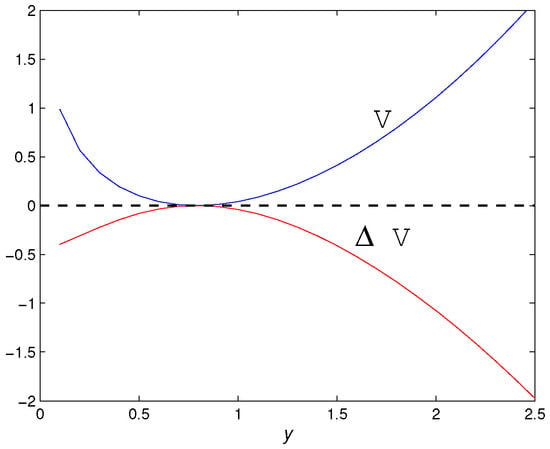
Figure 1.
V and function with and .
Theorem 3.
(The case of a strong Allee, i.e., ) Let y be a solution of the map (6) and the initial value . Then, we have:
- (1)
- When and , the map (6) has two positive fixed points and :
- (i)
- If , then .
- (ii)
- If , then .
- (2)
- Moreover, when and :
- (i)
- If , then .
- (ii)
- If , then .
- (3)
- When and or , then .
Proof.
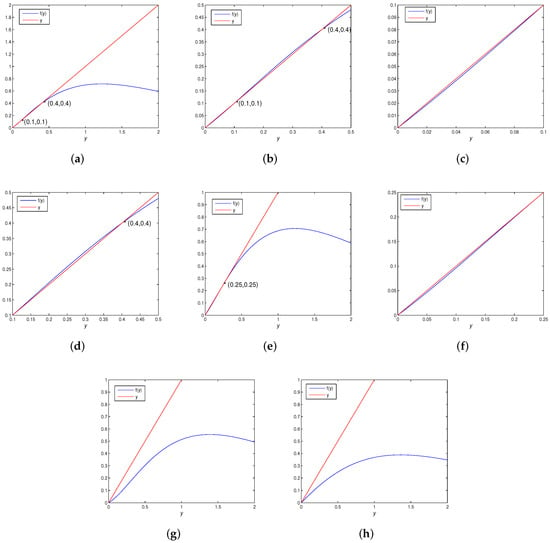
Map (6) can be simplified as follows:
where . Further, when and , if , we have , then (in Figure 2b,d); if , i.e., , then (in Figure 2a,b,d). Thus, if , the fixed point is globally asymptotically stable. In other cases, if , and , i.e., , then (in Figure 2c). When and , i.e., , then, if , (in Figure 2f); if then (in Figure 2e). When and or and , i.e., , then (in Figure 2g,h). Then, the result follows. □

Figure 2.
Positive fixed point existence diagram for map (6). (a) If , the map (6) has two positive fixed points . (b–d) Local diagrams with and corresponding to (a), respectively. (e) If , the map (6) has a unique positive fixed point . (f) Local diagrams with corresponding to (e), respectively. (g) If , the map (6) has no positive fixed point. (h) If , the map (6) also has no positive fixed point.
Table 1 gives the above analysis.

Table 1.
Fixed point of the map (6).
3. Dynamics Analysis of Map (5)
3.1. Existence and Local Stability of Fixed Points
The fixed points of the map (5) satisfy the equations as follows:
Obviously, and are two boundary fixed points of the map (5). Further, the other fixed points of the map (5) are summed up in Table 2. Let be the boundary fixed point of the extinction of the commensal species and = 1, 2, 3 be the fixed points of the coexistence of the two populations, where

Table 2.
Boundary and positive fixed point of the map (5)’s existence.
Remark 1.
To prepare for the prospect of bifurcations, we offer the following observations:
- (1)
- If then ;
- (2)
- If then
- (3)
- If then
At any fixed point the Jacobian matrix of the map (5) is given as
where Let the eigenvalues of the matrix be and .
We classify fixed points topologically and examine their local stability by [].
Definition 1.
A fixed point of the map (5) is called:
- (1)
- A sink if and and it is locally asymptotically stable;
- (2)
- A source if and and it is unstable;
- (3)
- A saddle if and (or and
- (4)
- Non-hyperbolic if either .
Now, using Definition 1, we topologically categorize fixed points and discuss their local stability.
Note that, when ,
and for the case ,
Thus, the following conclusion can be drawn.
Theorem 4.
Assume that and we have the following description:
- (1)
- is always a source since two eigenvalues are and
- (2)
- Two eigenvalues of are and . Then, is:
- (i)
- A saddle when
- (ii)
- A source when
- (iii)
- Non-hyperbolic when
By Theorem 4(iii), the two eigenvalues of are ; hence, is non-hyperbolic. The conditions that satisfy Theorem 4(iii) for the set are written as follows:
Choose the bifurcation parameter , and set it to . A suitably tiny perturbation term is . According to a quick calculation, the center manifold of the map (5) in is . In this instance, the map (5) may be expressed as . As a result, at , a flip bifurcation is formed.
Figure 3 depicts the bifurcation diagram of the numerical simulation for , and . Figure 3 shows that, when , the shape of the map (5) is stable; when , the map (5) turns over due to instability and provides stable biperiodic solutions. A chaotic set is produced as rises.
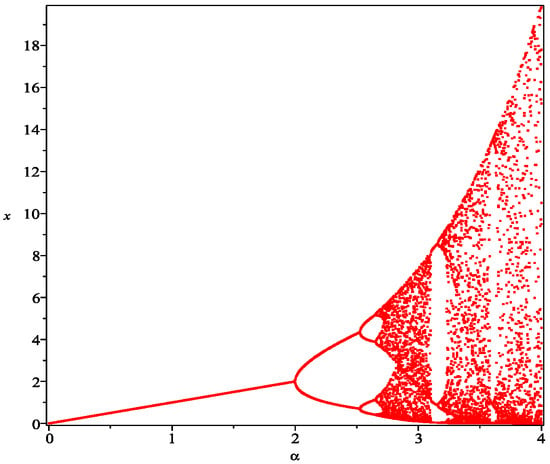
Figure 3.
Flip bifurcation diagrams of commensal species at initial value with and .
Theorem 5.
Assume that ; in this case, the two eigenvalues of the map (5) at fixed point are and then is:
- (1)
- A source if
- (2)
- A saddle if
- (3)
- Non-hyperbolic if .
Theorem 6.
The two eigenvalues of the map (5) at the fixed point are and ; consequently, is:
- (1)
- A sink if and only if and ;
- (2)
- A source if and only if and ;
- (3)
- A saddle if and only if and or and ;
- (4)
- Non-hyperbolic if or .
Proof.
At the boundary fixed point , whose eigenvalues are and it is simple to see that
and
Then, the result follows. □
Figure 4 displays the topological classification of the map (5) at boundary fixed point when , and .
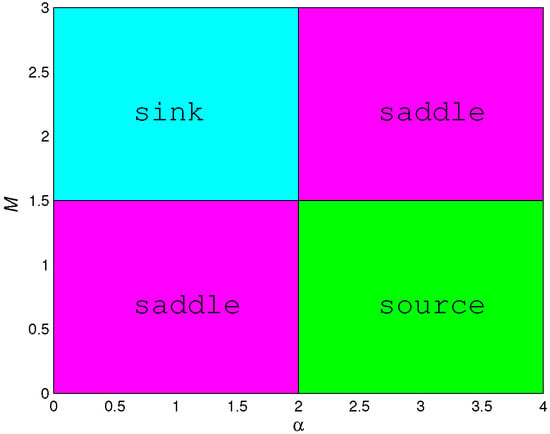
Figure 4.
Topological classification at with , and .
Now, we give the Jacobian matrix of the map (5) at the boundary fixed points as follows:
where . Clearly, the two eigenvalues of are and . Note that was analyzed in Section 2.2. Then, we have and . Thus, we obtain the following conclusions:
Theorem 7.
- (1)
- When and the boundary fixed point exists in the map (5), and the eigenvalues of are and . So, the fixed point is always a source.
- (2)
- When the boundary fixed point exists, the eigenvalues of are and . So, the fixed point is always a saddle.
- (3)
- When and the boundary fixed point exists in the map (5), and the eigenvalues of are and Consequently, is always non-hyperbolic.
Next, the Jacobian matrix at positive points is obtained as
where , whose eigenvalues are , and was analyzed above. Then, we obtain
This is equivalent to the following two situations.
- (1)
- If , we havewhere
- (2)
- If , we have , which is equivalent to .
As a consequence of the above analysis, we have:
Theorem 8.
- (1)
- When exists, it is:
- (i)
- A saddle if and only if and ;
- (ii)
- A source if and only if and or ;
- (iii)
- Non-hyperbolic if and only if and , where
- (2)
- When exists, it is:
- (i)
- A sink if and only if and ;
- (ii)
- A saddle if and only if and or ;
- (iii)
- Non-hyperbolic if and only if and , where
- (3)
- When exists and , it is always non-hyperbolic, where
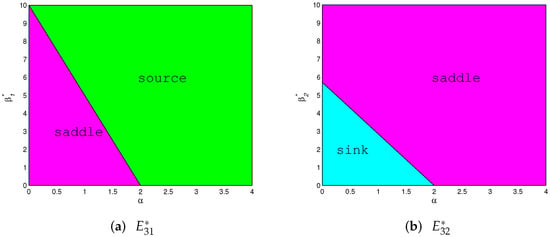
Figure 5.
Topological classification of the plane at with , , and .
3.2. Global Stability of Positive Fixed Point
Firstly, we give two lemmas in [].
Lemma 1.
Suppose that the sequences satisfy and
where a and b are positive constants. Then,
Lemma 2.
Suppose that the sequences satisfy and
where a and b are positive constants. Then,
where M was given by Lemma 2.
Secondly, from Theorem 2, we obtain that, if holds, is any positive solution of the map (6), then
Now, we consider a system as follows:
where is any positive solution of System (9). We obtain the following result.
Theorem 9.
Proof.
From (8), for any sufficiently small , there is an integer such that, if , then
In order to prove let
Then, by using the differential mean value theorem, the first equation of (5) can be expressed as
where , and lies in the range of to . Now, our primary purpose is to prove
because of then with the help of Lemmas 1 and 2, we obtain
In addition, from (9), Lemmas 1 and 2, we obtain
Thus, for any sufficiently small , there is an integer such that, if , then
Suppose that
Then, for any sufficiently small , we suppose
Then, we obtain the following inequality:
3.3. Bifurcation Analysis of a Codimension of One
According to the prior analysis of the map (5) at fixed points, in this section, the center manifold theorem is used to reduce dimensionality, and then, bifurcation theory is employed to investigate the bifurcations of a codimension of one at non-hyperbolic fixed points by [,].
3.3.1. Bifurcation at the Fixed Point
Theorem 10.
When parameters , is a non-hyperbolic fixed point. Furthermore, we find that the map (5) will undergo:
- (1)
- A transcritical bifurcation when parameters hold;
- (2)
- A pitchfork bifurcation when holds.
Proof.
By Theorem 5, the two eigenvalues of are , and the fixed point is called non-hyperbolic if . We choose M as the bifurcation parameter, and is the perturbation parameter near A, satisfying . Then, through an iterative operation, we can easily calculate that the center manifold of the map (5) is given as and that the constrained map (5) can be represented as . If holds, thus the map (5) undergoes a transcritical bifurcation at ; if , then the map (5) undergoes a pitchfork bifurcation at . □
3.3.2. Bifurcation around Boundary Fixed Point
Theorem 11.
The map (5) at has:
- (i)
- A transcritical bifurcation or a pitchfork bifurcation, whose boundary fixed point is non-hyperbolic, if parameter or , respectively;
- (ii)
- A flip bifurcation if .
Proof.
According to Theorem 6(4), when the parameters satisfy the conditions , one eigenvalue of the Jacobian matrix is and the other is 1. First, we choose M as the bifurcation parameter. Set , where , and it is a new variable. Next, we translate System (5) to the originwith and perform the Taylor expansion, leading to
here,
and
The matrix of the linear part of the map (17) can be expressed as:
Choose invertible matrix T:
Apply the following matrix transformation to the map (17):
Then, to study the stability of near , we can indirectly study a system of one-parameter equations limited to a center manifold. It can be defined as follows:
with V and small. Take
Then, we have
Thus, the map restricted to the center manifold is written as
We can see that
Hence, the map (5) undergoes a transcritical bifurcation at because of if . Moreover, when , a direct calculation leads to and ; from [] the map (5) will pass through a pitchfork bifurcation at .
From Theorem 6(4), when holds, it is evident that, for the non-hyperbolic , and . Taking as a bifurcation parameter and assuming that is a sufficiently small perturbation parameter, namely , then, the perturbations corresponding to System (5) are mapped as follows:
Taking the map (23) at origin , the Jacobian matrix is
Invertible matrices T are constructed as follows:
According to the center manifold theory, is stable for and can be determined as follows:
with small and X. Assuming that
must satisfy the following relation:
Consequently, the map restricted to the center manifold is expressed as
From [], it can be seen that the conditions for flip bifurcation to occur are:
Thus, by [], the system (5) undergoes a flip bifurcation if holds at . □
3.3.3. Bifurcation Analysis of Positive Fixed Point
Theorem 12.
If exists, the map (5) has:
- (a)
- A flip bifurcation for parameter at .
- (b)
- A fold bifurcation for parameter at . In addition, with the increase of M, the number of positive fixed points of the map (5) has a 2-1-0 change. That is, when , there are and ; when , there is a unique positive fixed point , and when the positive fixed point disappears.
Proof.
From Theorem 8, we can easily obtain that, when , . Then, to obtain the flip bifurcation, we regard as the bifurcation parameter and shift the fixed point to through a transformation and ; here, and is a sufficiently small new variable. We then have
here,
and
The linearization matrix for the map (28) is
Find an invertible matrix T, for instance
and make the transformation:
the map (18) yields
where
where
According to the center manifold theory, a one-parameter simplified system of equations restricted to the manifold determines the stability of in the neighborhood of , given by
with X and sufficiently small. Moreover, let
thus,
Hence, the map restricted to the center manifold becomes
where
We give the following two transversal conditions in []:
Therefore, a flip bifurcation occurs when at the fixed point .
From Theorem 8(3), it is easy to obtain that, when , . Now, we select M as the bifurcation parameter. Take , , and it is a new variable. We transform the fixed point of the map (5) to with , and then, the map (5) becomes
where
The coefficient matrix is given by
Convertthe matrix in (33) into the normal form with matrix translation as follows:
where
is an invertible matrix. From (33) and (34), we have
where
and
By implementing the center manifold theorem, the stability of the map (35) at in a neighborhood of can be approximated as follows:
with X and small. Then, assume
and have the following equation
Thus, the restricted map to the center manifold is given as
We can simply calculate
which leads to a fold bifurcation when at the . □
3.4. Chaos Control
From Theorem 12(a), it can be seen that a flip bifurcation of the map (5) is shown at the coexistence fixed point . This will cause chaos in the system, so we use a hybrid chaos-control method in [], which is a combination of parameter perturbation and feedback control, to delay or get rid of chaos. First, the control system corresponding to the map (5) is given by
where and is an external control parameter. Moreover, the calculation shows that System (38) and the map (5) have the same fixed points. The linearized Jacobian matrix of the map (38) at fixed point is
Obviously, the two eigenvalues of the Jacobian matrix are and . According to the previous analysis, , then . We have . Therefore, with the help of Definition 1(1), the controlled system (38) has the following statement.
Theorem 13.
4. Numerical Simulations
In this section, the analysis results obtained above are further studied through numerical simulations.
Case (1): Select different parameters of the map (6), in Table 3, to observe the solution curve in Figure 6.

Table 3.
Parameter table.
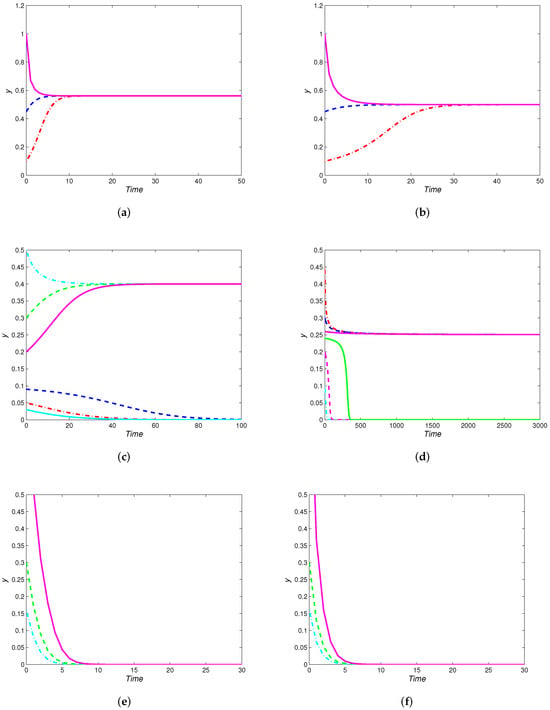
Figure 6.
(a) With , and the initial value as , the map (6) has positive fixed points ; (b) with and the initial value as , the map (6) has positive fixed points ; (c) with , and the initial value as , the map (6) has two positive fixed points ; (d) with , and the initial value as , the map (6) has positive fixed points ; (e) with , and the initial value as , the map (6) has no positive fixed point; (f) with , and the initial value as , the map (6) has no positive fixed point.
Case (2): Set parameters and initial values as in the map (5). There is a positive fixed point and global asymptotic stability by Theorem 9. Figure 7 shows the result.
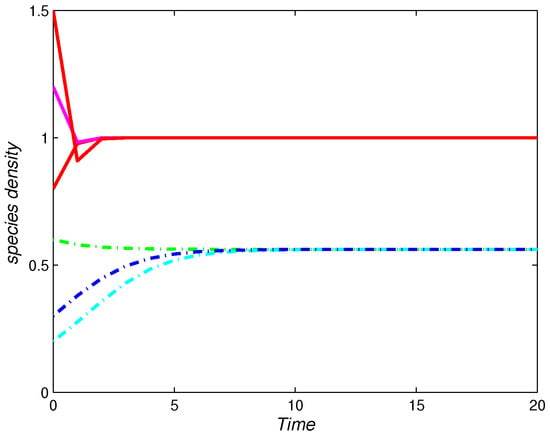
Figure 7.
Stability of the fixed point of the map (5) with , and the initial values as .
Case (3): Set parameters in the map (5). We find that the two eigenvalues of the Jacobian matrix at the boundary fixed point are . Therefore, by Theorem 6, the fixed point is non-hyperbolic. According to Theorem 11(i) of the bifurcation analysis, the map (5) has transcritical bifurcation at .
Figure 8 is a diagram of the transcritical bifurcation on the plane in the local range of the fixed point when , and the other parameters are given in Case (3). From Figure 8, it can be found that, when , is unstable, but when , there is a stable fixed point and an unstable fixed point .
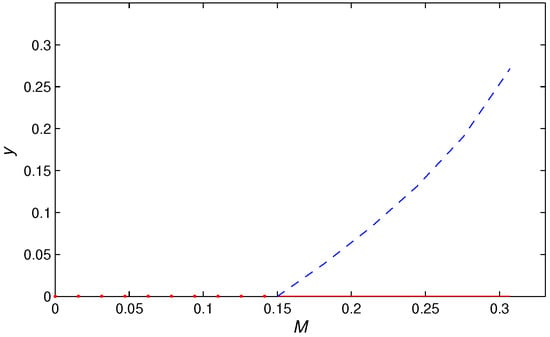
Figure 8.
Transcritical bifurcation diagrams in the plane with .
Case (4): Further, based on Case (3), we change the parameter A and let . At this time, by Theorem 11(ii), the map (5) generates a pitchfork bifurcation at . Namely, it is a pitchfork bifurcation point.
Figure 9 is a diagram of the pitchfork bifurcation on the plane in the local area of the fixed point . Select the initial value of , and . It can be seen from Figure 9 that the fixed point is unstable, when ; the stable fixed point appears when . Additionally, there are two stable fixed points and when ; and coincide to form the double-root when ; disappears when .
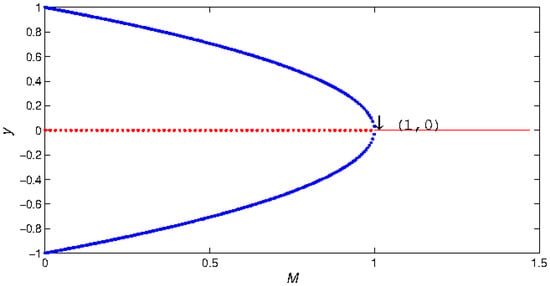
Figure 9.
Pitchfork bifurcation diagrams in the plane with .
Case (5): Set the parameters in the map (5). When , the corresponding eigenvalues of the matrix are , respectively. From Theorem 8(2)(iii), is non-hyperbolic. Further, from Theorem 12(a), the map (5) has a flip bifurcation at .
Figure 10a describes the diagram of the flip bifurcation on the plane at the initial value , , and the other parameters are shown in Case (5). From Figure 10a, the coexistence equilibria are stable when , and when , the map (5) is unstable, resulting in a stable two-period solution; when , it will further generate four-dimensional solutions and constantly flip to generate chaotic sets.
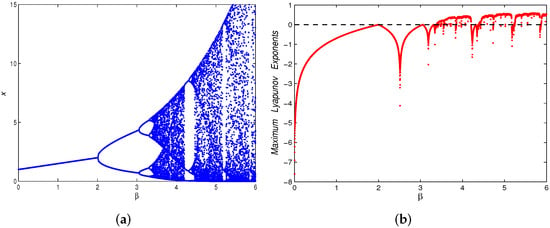
Figure 10.
(a) Flip bifurcation diagrams on the plane with ; (b) maximum Lyapunov exponents corresponding to (a).
Figure 10b shows the maximum Lyapunov exponents of Figure 10a, and ranges in . When the exponent value is less than 0, this indicates that the map (5) is stable in the small field of . In other words, when the exponent value is greater than 0, the map (5) is chaotic in the small field of . From Figure 10b, when varies in , the index is negative, except for , which is 0. When belongs to , the index is only 0 at and , and in other cases, the index is negative. When is greater than , most of the indices are positive and very few are negative numbers, which indicates that the map (5) produces chaotic behavior near the fixed point . We also give local bifurcation diagrams in Figure 11. Further, when we choose , the phase diagrams are depicted in Figure 12. As increases, it can be seen from Figure 12 that there will be one point, two points, four points, eight points, etc., gradually becoming chaotic.
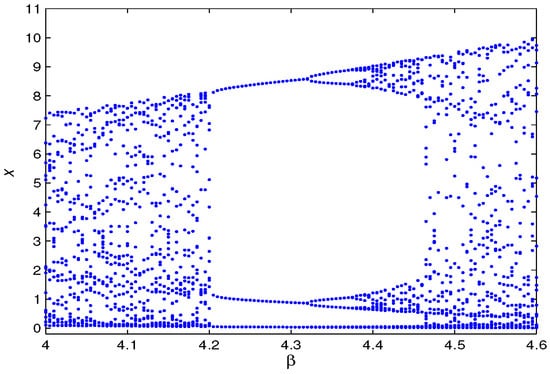
Figure 11.
Local bifurcation diagrams corresponding to Figure 10a.

Figure 12.
Phase diagrams corresponding to Figure 10a.
Case (6): To study the impact of the Allee effect on the dynamic behavior of the map (5), we used the matlab 2017a drawing software to give the bifurcation diagram on the plane and . We selected four sets of parameters. (a) Set the parameter , ; (b) set the parameter , ; (c) set the parameter , ; (d) set the parameter , , taking the initial value .
From Figure 13a,c, it is shown that, with the increase of M, it helps the stability of the commensal populations. Further, we also found that a strong Allee effect reduces the species density of the commensal. Figure 13b,d are graphs showing the impact of the Allee effect M on the population density of the host species. It can be seen from Figure 13b,d that, if M increases, the host population is accelerated to extinction. It can be seen from Figure 13e,f that, as M increases, the map (5) moves from chaos to a two-period solution, but the map (5) is unstable.
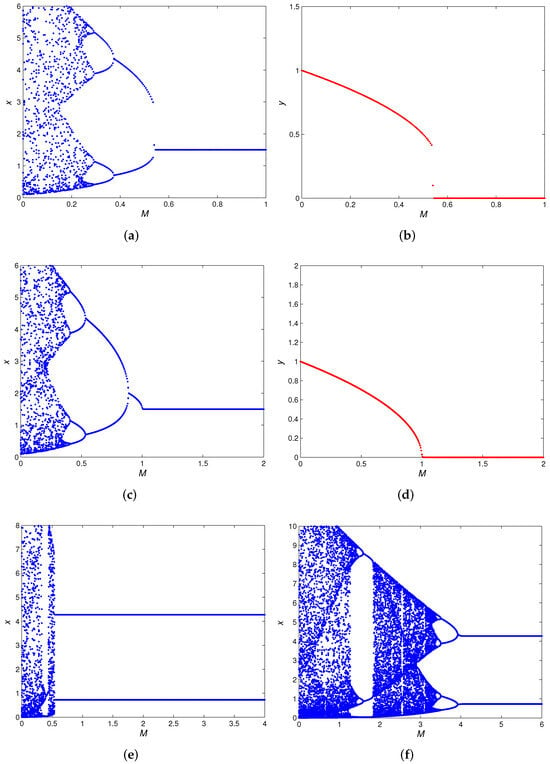
Figure 13.
(a) Bifurcation diagrams in the plane with ; (b) bifurcation diagrams in the plane with ; (c) bifurcation diagrams in the plane with ; (d) bifurcation diagrams in the plane with ; (e) bifurcation diagrams in the plane with ; (f) bifurcation diagrams in the plane with .
Case (7): Set parameters in the map (5). We can simply calculate . Then, the eigenvalues of the Jacobian matrix of the map (5) are , respectively. By Theorem 8(3), is non-hyperbolic. Through the bifurcation study of Theorem 12(b), a fold bifurcation occurs at coexistence equilibrium , which is also called a fold point.
Figure 14 is a diagram of fold bifurcation on the plane within the local range of the fixed point . Select the initial value , and other parameters are given in Case (7). As M increases from 0 to , the map (5) has an unstable fixed point (shown in red) and a stable fixed point (shown in blue). At , System (5) undergoes a fold (also called saddle-node) bifurcation at . Then, the fixed point vanishes for .
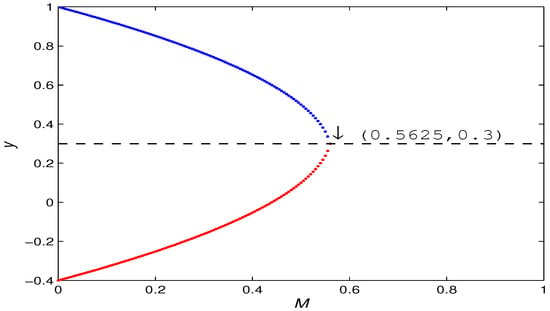
Figure 14.
Fold bifurcation diagrams in the plane with .
Case (8): Set the parameters , and the initial value . We can simply calculate , and is equivalent to . Moreover, implies that . So, let us take a smaller . From Theorem 13, when , it is locally asymptotically stable. Figure 15 shows that when the external control parameters change in the range [0,0.57], the map (5) can be stabilized again. In addition, we set the parameter , then the stability region diagram is given of the control system (28) in Figure 16.
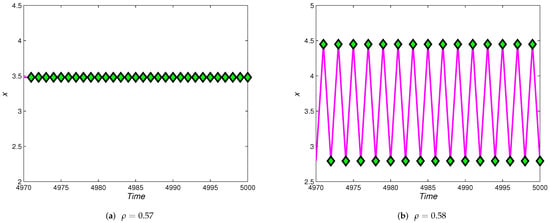
Figure 15.
Time series of the commensal species for (28) with . (a) ; (b) .
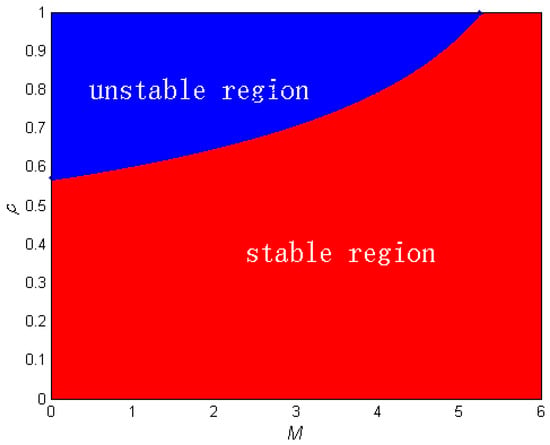
Figure 16.
Stability region diagram in the plane with .
5. Summary
This paper investigated a discrete-time commensalism mode with an additive Allee effect for the host species. First, we gave the existence and local stability of fixed points in the map (6), and we found that, under the weak Allee effect, the system has a unique positive fixed point of global attraction. Under the strong Allee effect, the stability of the system is related to the attraction domain, which has similar properties to the corresponding continuous system. Secondly, we studied the existence and stability of the solutions of the map (5), then gave the possible bifurcation of the map (5) by the center manifold theorem and bifurcation theory. We found that the map (5) has new bifurcation phenomena, such as flip and pitchfork bifurcations, which could not be found in the corresponding continuous-time system. Wei et al. [] presented a commensal model with additive Allees in the first species and discussed the occurrence of saddle-node bifurcation and transcritical bifurcation. Examining a Lotka–Volterra commensal model featuring an Allee effect within the first species, Lin [] revealed that heightened Allee effects lead to an escalation in the final population density of the species. In [], Chen examined a comparable two-species commensal symbiosis model and noted that the Allee effect introduces instability to the system; nevertheless, this effect can be managed and controlled. From our investigation, it was revealed that the Allee increases the system complexity through multiple bifurcations. Recently, the studies by He et al. [] revealed that, in the case of the weak Allee effect, the additive Allee effect negatively correlated with the final population density of both species. For a strong Allee effect, the additive Allee effect played a significant role in the extinction of the second species. Our study in this domain showed more-complex dynamics in comparison to the continuous-time model (2), which were presented through bifurcation analysis. Through numerical simulations of our proposed model, in the case where the first population had a lower birth rate, we observed that the Allee effect enhanced the stability of the commensal species, while hastening the extinction of the host species (see Figure 13a–d). These intricate and multifaceted dynamic behaviors mark our model as a truly novel contribution. Moreover, the map (5) may also have a fold–flip bifurcation of a codimension of two at fixed point , which is something we need to study in the future. When , the map (5) has at most four positive fixed points, and only flip bifurcation can occur. When , the system may have six positive fixed points, and they may undergo flip, fold, transcritical, pitchfork, and fold–flip bifurcations, which are left for future investigation.
Author Contributions
Y.C. was mainly responsible for the writing of the first draft of the article, and A.J.K. substantially rewrote the preface and conclusion sections, embellished the presentation of the full text, explored the flip bifurcation, and also, carefully and meticulously reviewed the the full text. S.C. was responsible for the numerical simulation part of the article drawings with the MATLAB software. F.C. was responsible for correcting the details and logic of the article. All authors have read and agreed to the published version of the manuscript.
Funding
This work was supported by the Natural Science Foundation of Fujian Province (2020J01499).
Data Availability Statement
Not applicable.
Conflicts of Interest
The authors declare no conflict of interest.
References
- Mathis, K.A.; Bronstein, J.L. Our current understanding of commensalism. Annu. Rev. Ecol. Evol. Syst. 2020, 51, 167–189. [Google Scholar] [CrossRef]
- Leung, T.L.; Poulin, R. Parasitism, commensalism, and mutualism: Exploring the many shades of symbioses. Vie Milieu 2008, 58, 107–115. [Google Scholar]
- Anderson, B.; Midgley, J.J. Density-dependent outcomes in a digestive mutualism between carnivorous Roridula plants and their associated hemipterans. Oecologia 2007, 152, 115–120. [Google Scholar] [CrossRef]
- Heard, S.B. Pitcher-plant midges and mosquitoes: A processing chain commensalism. Ecology 1994, 75, 1647–1660. [Google Scholar] [CrossRef]
- Hari, P.B.; Pattabhi, R.N.C. Discrete model of commensalism between two species. Int. J. Mod. Edu. Comput. Sci. 2012, 8, 40–46. [Google Scholar]
- Sun, G.C.; Wei, W.L. The qualitative analysis of commensal symbiosis model of two populations. Math. Theory Appl. 2003, 23, 65–68. [Google Scholar]
- Chen, F.D.; Chong, Y.B.; Lin, S.J. Global stability of a commensal symbiosis model with Holling II functional response and feedback controls. Wseas Trans. Syst. Contr. 2022, 17, 279–286. [Google Scholar] [CrossRef]
- Wu, R.X.; Li, L.; Lin, Q.F. A Holling type commensal symbiosis model involving Allee effect. Commun. Math. Biol. Neurosci. 2018, 2018, 6. [Google Scholar]
- Chen, B.G. The influence of commensalism on a Lotka–Volterra commensal symbiosis model with Michaelis–Menten type harvesting. Adv. Differ. Equ. 2019, 2019, 43. [Google Scholar] [CrossRef]
- Xu, L.L.; Lin, Q.F.; Lei, C.Q. Dynamic behavior of commensal symbiosis system with both feedback control and Allee effect. J. Shanghai Norm. Univ. 2022, 51, 391–396. [Google Scholar]
- He, X.Q.; Zhu, Z.L.; Chen, J.L.; Chen, F. Dynamical analysis of a Lotka Volterra commensalism model with additive Allee effect. Open Math. 2022, 20, 646–665. [Google Scholar] [CrossRef]
- Georgescu, P.; Maxin, D.; Zhang, H. Global stability results for models of commensalism. Int. J. Biol. 2017, 10, 1750037. [Google Scholar] [CrossRef]
- Chen, B.G. Dynamic behaviors of a commensal symbiosis model involving Allee effect and one party can not survive independently. Adv. Differ. Equ. 2018, 2018, 212. [Google Scholar] [CrossRef]
- Chen, J.H.; Wu, R.X. A commensal symbiosis model with non-monotonic functional response. Math. Biol. Neurosci. 2017, 2017, 5. [Google Scholar]
- Lin, Q.F. Dynamic behaviors of a commensal symbiosis model with non-monotonic functional response and non-selective harvesting in a partial closure. Commun. Math. Biol. Neurosci. 2018, 2018, 4. [Google Scholar]
- Li, T.T.; Lin, Q.X.; Chen, J.H. Positive periodic solution of a discrete commensal symbiosis model with Holling II functional response. Commun. Math. Biol. Neurosci. 2016, 2016, 22. [Google Scholar]
- Xie, X.D.; Miao, Z.S.; Xue, Y.L. Positive periodic solution of a discrete Lotka–Volterra commensal symbiosis model. Commun. Math. Biol. Neurosci. 2015, 2015, 2. [Google Scholar]
- Han, R.Y.; Chen, F.D. Global stability of a commensal symbiosis model with feedback controls. Commun. Math. Biol. Neurosci. 2015, 2015, 15. [Google Scholar]
- Zhou, Q.M.; Lin, S.J.; Chen, F.D.; Wu, R. Positive periodic solution of a discrete Lotka–Volterra commensal symbiosis model with Michaelis–Menten type harvesting. Wseas Trans. Math. 2022, 21, 515–523. [Google Scholar] [CrossRef]
- Chen, S.M.; Chong, Y.B.; Chen, F.D. Periodic solution of a discrete commensal symbiosis model with Hassell–Varley type functional response. Nonauton. Dyn. Syst. 2022, 9, 170–181. [Google Scholar] [CrossRef]
- Xu, L.L.; Xue, Y.L.; Lin, Q.F.; Lei, C. Global attractivity of symbiotic model of commensalism in four populations with Michaelis—Menten type harvesting in the first commensal populations. Axioms 2022, 11, 337. [Google Scholar] [CrossRef]
- Zhu, Z.L.; Wu, R.X.; Chen, F.D.; Li, Z. Dynamic behaviors of a Lotka–Volterra commensal symbiosis model with non-selective Michaelis–Menten type harvesting. IAENG Int. J. Appl. Math. 2020, 50, 1–9. [Google Scholar]
- Liu, Y.; Guan, X.Y.; Xie, X.D.; Lin, Q. On the existence and stability of positive periodic solution of a nonautonomous commensal symbiosis model with Michaelis–Menten type harvesting. Commun. Math. Biol. Neurosci. 2019, 2019, 2. [Google Scholar]
- Jawad, S. Study the dynamics of commensalism interaction with Michaels-Menten type prey harvesting. Al-Nahrain J. Sci. 2022, 25, 45–50. [Google Scholar] [CrossRef]
- Chen, F.D.; Chen, Y.M.; Li, Z.; Chen, L. Note on the persistence and stability property of a commensalism model with Michaelis—Menten harvesting and Holling type II commensalistic benefit. Appl. Math. Lett. 2022, 134, 108381. [Google Scholar] [CrossRef]
- Lei, C.Q. Dynamic behaviors of a Holling type commensal symbiosis model with the first species subject to Allee effect. Commun. Math. Biol. Neurosci. 2019, 2019, 3. [Google Scholar]
- Guan, X.Y. Stability analysis of a Lotka–Volterra commensal symbiosis model involving Allee effect. Ann. Appl. Math. 2018, 34, 364–375. [Google Scholar]
- Seval, I. Stability and period-doubling Bifurcation in a modified commensal symbiosis model with Allee effect. Erzin. Univ. J. Sci. Technol. 2022, 15, 310–324. [Google Scholar]
- Li, T.Y.; Wang, Q.R. Bifurcation analysis for two-species commensalism (amensalism) systems with distributed delays. Int. J. Bifurc. Chaos 2022, 32, 2250133. [Google Scholar] [CrossRef]
- Li, T.Y.; Wang, Q.R. Stability and Hopf bifurcation analysis for a two-species commensalism system with delay. Qual. Theory Dyn. Syst. 2021, 20, 83. [Google Scholar] [CrossRef]
- Allee, W.C. Animal Aggregations, a Study in General Sociology; University of Chicago Press: Chicago, IL, USA, 1931. [Google Scholar]
- Allee, W.C. The Social Life of Animals; William Heinemann: London, UK, 1938. [Google Scholar]
- Gonzalez-Olivares, E.; Mena-Lorca, J.; Rojas-Palma, A.; Flores, J.D. Dynamical complexities in the Leslie-Gower predator-prey model as consequences of the Allee effect on prey. Appl. Math. Model. 2011, 35, 366–381. [Google Scholar] [CrossRef]
- Sun, G.Q. Mathematical modeling of population dynamics with Allee effect. Nonlinear Dyn. 2016, 85, 1–12. [Google Scholar] [CrossRef]
- Zhang, J.H.; Chen, X.Y. Dynamic behaviors of a discrete commensal symbiosis model with Holling type functional response. IAENG Int. J. Appl. Math. 2023, 53, 277–281. [Google Scholar]
- Kundu, K.; Pal, S.; Samanta, S.; Sen, A.; Pal, N. Impact of fear effect in a discrete-time predator-prey system. Bull. Calcutta Math. Soc. 2018, 110, 245–264. [Google Scholar]
- Zhou, Q.M.; Chen, F.D.; Lin, S.J. Complex dynamics analysis of a discrete amensalism system with a cover for the first species. Axioms 2022, 11, 365. [Google Scholar] [CrossRef]
- Zhou, Q.M.; Chen, F.D. Dynamical analysis of a discrete amensalism system with the Beddington—DeAngelis functional response and Allee effect for the unaffected species. Qual. Theory Dyn. Syst. 2023, 22, 16. [Google Scholar] [CrossRef]
- Garai, S.; Pati, N.C.; Pal, N.; Layek, G.C. Organized periodic structures and coexistence of triple attractors in a predator-prey model with fear and refuge. Chaos Solitons Fractals 2022, 165, 112833. [Google Scholar] [CrossRef]
- Zhang, L.; Zhang, C.; He, Z. Codimension-one and codimension-two bifurcations of a discrete predator-prey system with strong Allee effect. Math. Comput. Sim. 2019, 162, 155–178. [Google Scholar] [CrossRef]
- Chen, Q.L.; Teng, Z.D.; Wang, F. Fold–flip and strong resonance bifurcations of a discrete-time mosquito model. Chaos Solitons Fractals 2021, 144, 110704. [Google Scholar] [CrossRef]
- Jiang, H.; Rogers, T.D. The discrete dynamics of symmetric competition in the plane. J. Math. Bio. 1987, 25, 573–596. [Google Scholar] [CrossRef]
- Liu, X.L.; Xiao, D.M. Complex dynamic behaviors of a discrete-time predator-prey system. Chaos Solitons Fractals 2007, 32, 80–94. [Google Scholar] [CrossRef]
- Kuznetsov, Y. Elements of Applied Bifurcation Theory; Springer: New York, NY, USA, 1998. [Google Scholar]
- Winggins, S. Introduction to Applied Nonlinear Dynamical Systems and Chaos; Springer: New York, NY, USA, 2003. [Google Scholar]
- Luo, X.S.; Chen, G.; Wang, B.H.; Fang, J.Q. Hybrid control of period-doubling bifurcation and chaos in discrete nonlinear dynamical systems. Chaos Solitons Fractals 2003, 18, 775–783. [Google Scholar] [CrossRef]
- Wei, Z.; Xia, Y.H.; Zhang, T.H. Stability and bifurcation analysis of a commensal model with additive Allee effect and nonlinear growth rate. Int. J. Bifurc. Chaos 2021, 31, 2150204. [Google Scholar] [CrossRef]
- Lin, Q.F. Allee effect increasing the final density of the species subject to the Allee effect in a Lotka–Volterra commensal symbiosis model. Adv. Differ. Equ. 2018, 2018, 196. [Google Scholar] [CrossRef]
Disclaimer/Publisher’s Note: The statements, opinions and data contained in all publications are solely those of the individual author(s) and contributor(s) and not of MDPI and/or the editor(s). MDPI and/or the editor(s) disclaim responsibility for any injury to people or property resulting from any ideas, methods, instructions or products referred to in the content. |
© 2023 by the authors. Licensee MDPI, Basel, Switzerland. This article is an open access article distributed under the terms and conditions of the Creative Commons Attribution (CC BY) license (https://creativecommons.org/licenses/by/4.0/).